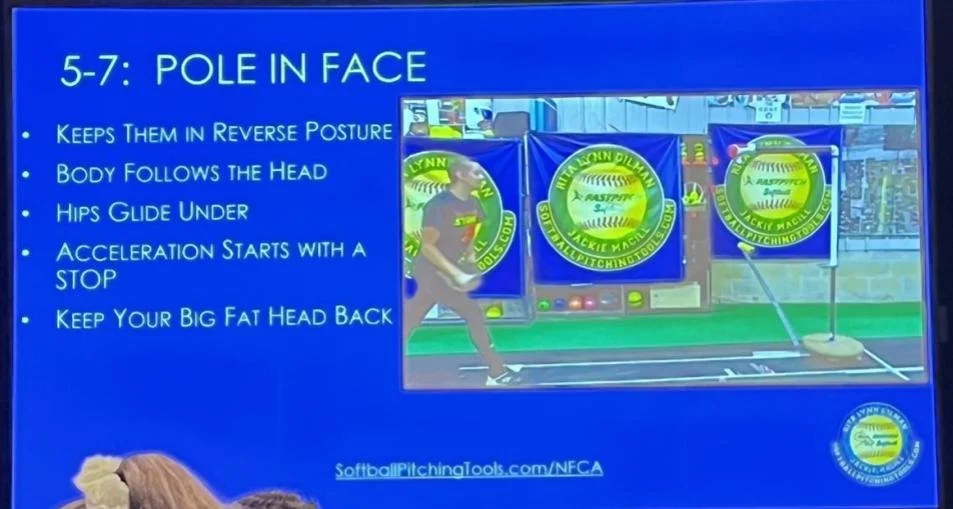Tips About Pitching From an Industry Expert
/Happy New Year to Everyone!
Aren’t new beginnings the best? I always loved school shopping with brand new folders & notebooks and binders & pens. I felt ready to take on the school year! I feel like that at the beginning of every pitching school session as well. You all inspire me as your coach to help you reach new heights. And as we enter a new year, fresh with hopes of resolutions to be met, I am excited to share the “new” things that I learned at the annual NFCA convention, held in San Antonio, Texas this past December of 2022. For those of you who are loyal blog readers, you knew that I would be circling around to the exciting pitching topics presented by some of the most successful coaches in the game. And over the next few weeks, I will be discussing the three pitching presentations that wowed me at convention. I believe we all can learn something new and helpful to become better pitchers from people who emphasize different parts of the mechanics or have focal points that may help us revisit a concept we’ve been trying to master in a new way.
The first of the three presenters that I’d like to share what I learned from is Rita Lynn Gilman. She is a private lessons pitching instructor out of Virginia who coaches young women in grade school, middle school, and high school. She has had some of the most successful collegiate pitchers to come through her ranks, including Lacy Waldrop, 2014 Player of the Year (All-American Pitcher from Florida State).
Rita presented so many tools and concepts that I loved (many of which I’ll be incorporating into our pitching school sessions). But I want to highlight a couple concepts she presented and gadgets she uses to improve speed, spin, and control.
First, Rita believes that control is a pitch. Mastering the fastball mechanics and spin to specific targets will make you extremely successful. Elite C-Fastball spin becomes a peel drop, which is a highly effective pitch, number one. But her validation that creating a repeatable motion that can hit precise targets being a pitch that will help you win is extremely important to buy into. As you work towards perfecting your motion week to week in pitching school and creating a mechanically sound repeatable release point that allows you to direct the ball to specific targets on command is the number one piece to creating success on the mound in a game. That should light a fire or encouragement under each of you! You each learn and practice great mechanics and a repeatable release with a C-Fastball regularly. Focusing on this and accomplishing the goal of 80% control with your fastball will create exceptional success for you when you bring your talents to a game. Additionally, you’ll develop a killer peel drop to use to foil your opponents.
One of the ways that Rita encourages her players to create that repeatable motion and release point is through mirror work. Sound familiar to you? She says to start without a ball because the ball can be evil and cause you to pay attention to the outcome over the process, so start your mirror work with just your body rehearsing (before you put the ball in your hand and throw into a net). I love that, and all of us can practice this in the comfort of our own bedrooms at home. How awesome is that?
Second, Coach Gilman believes that the fingers and the hand and arm speed is much more important to creating speed, spin, and control than anything else in the motion. Adding in the take away, stride, and legs will only increase your speed up to a maximum of 10 mph. So stationary drills that promote arm speed, hand whip, finger rip are the keys to velocity building. One of my favorite gadgets that she showed us that her pitchers use is a ball with Velcro on it to really feel the pads of one’s fingers ripping off the ball. Take a look at this:
The last concept that Coach Rita presented that I want to share with you today is that our “head” guides our body. And most times, the reason we have trouble incorporating our legs into our pitch appropriately (putting the brakes on at resistance and then using the ground force and correctly stacked shoulders, hips, and knees to propel the ball forward with ultimate force), is because our head is too far forward. If we keep our head back, we can more easily get into reverse posture that promotes the optimal position to create resistance and leg drive. Therefore, Coach Gilman has created a “pole in face” contraption so that her pitchers make sure to keep their face back so that they don’t “hit the pole with their face” on the stride forward. It’s a very practical idea to force good posture and utilize our legs most effectively. Take a look at Rita’s pole that she uses in her lessons:
I hope you found one or all of these concepts interesting to learn about as I did. I can’t wait to discuss which one you’d like to try first at our next pitching school class.
Have a great week and Happy New Year!






